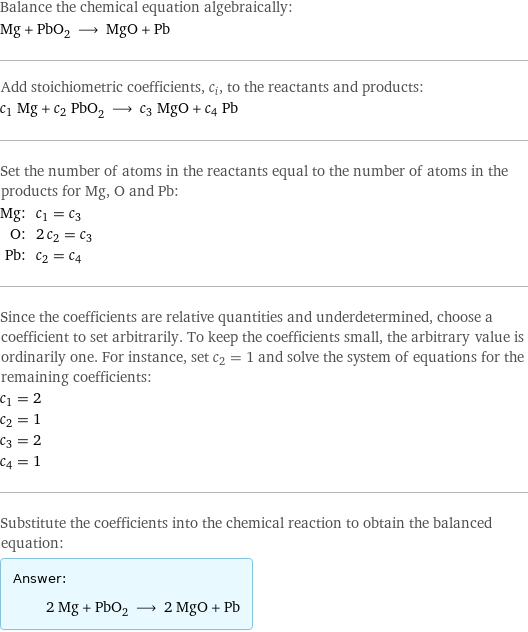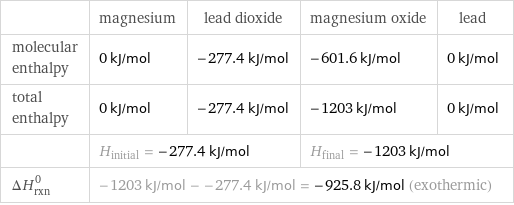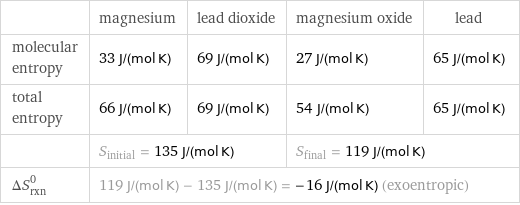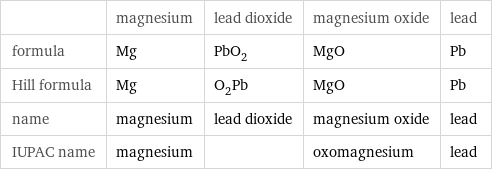Input interpretation

Mg magnesium + PbO_2 lead dioxide ⟶ MgO magnesium oxide + Pb lead
Balanced equation

Balance the chemical equation algebraically: Mg + PbO_2 ⟶ MgO + Pb Add stoichiometric coefficients, c_i, to the reactants and products: c_1 Mg + c_2 PbO_2 ⟶ c_3 MgO + c_4 Pb Set the number of atoms in the reactants equal to the number of atoms in the products for Mg, O and Pb: Mg: | c_1 = c_3 O: | 2 c_2 = c_3 Pb: | c_2 = c_4 Since the coefficients are relative quantities and underdetermined, choose a coefficient to set arbitrarily. To keep the coefficients small, the arbitrary value is ordinarily one. For instance, set c_2 = 1 and solve the system of equations for the remaining coefficients: c_1 = 2 c_2 = 1 c_3 = 2 c_4 = 1 Substitute the coefficients into the chemical reaction to obtain the balanced equation: Answer: | | 2 Mg + PbO_2 ⟶ 2 MgO + Pb
Structures

+ ⟶ +
Names

magnesium + lead dioxide ⟶ magnesium oxide + lead
Reaction thermodynamics
Enthalpy

| magnesium | lead dioxide | magnesium oxide | lead molecular enthalpy | 0 kJ/mol | -277.4 kJ/mol | -601.6 kJ/mol | 0 kJ/mol total enthalpy | 0 kJ/mol | -277.4 kJ/mol | -1203 kJ/mol | 0 kJ/mol | H_initial = -277.4 kJ/mol | | H_final = -1203 kJ/mol | ΔH_rxn^0 | -1203 kJ/mol - -277.4 kJ/mol = -925.8 kJ/mol (exothermic) | | |
Entropy

| magnesium | lead dioxide | magnesium oxide | lead molecular entropy | 33 J/(mol K) | 69 J/(mol K) | 27 J/(mol K) | 65 J/(mol K) total entropy | 66 J/(mol K) | 69 J/(mol K) | 54 J/(mol K) | 65 J/(mol K) | S_initial = 135 J/(mol K) | | S_final = 119 J/(mol K) | ΔS_rxn^0 | 119 J/(mol K) - 135 J/(mol K) = -16 J/(mol K) (exoentropic) | | |
Equilibrium constant
![Construct the equilibrium constant, K, expression for: Mg + PbO_2 ⟶ MgO + Pb Plan: • Balance the chemical equation. • Determine the stoichiometric numbers. • Assemble the activity expression for each chemical species. • Use the activity expressions to build the equilibrium constant expression. Write the balanced chemical equation: 2 Mg + PbO_2 ⟶ 2 MgO + Pb Assign stoichiometric numbers, ν_i, using the stoichiometric coefficients, c_i, from the balanced chemical equation in the following manner: ν_i = -c_i for reactants and ν_i = c_i for products: chemical species | c_i | ν_i Mg | 2 | -2 PbO_2 | 1 | -1 MgO | 2 | 2 Pb | 1 | 1 Assemble the activity expressions accounting for the state of matter and ν_i: chemical species | c_i | ν_i | activity expression Mg | 2 | -2 | ([Mg])^(-2) PbO_2 | 1 | -1 | ([PbO2])^(-1) MgO | 2 | 2 | ([MgO])^2 Pb | 1 | 1 | [Pb] The equilibrium constant symbol in the concentration basis is: K_c Mulitply the activity expressions to arrive at the K_c expression: Answer: | | K_c = ([Mg])^(-2) ([PbO2])^(-1) ([MgO])^2 [Pb] = (([MgO])^2 [Pb])/(([Mg])^2 [PbO2])](../image_source/e41acb79a36cb0f20686981a939a268a.png)
Construct the equilibrium constant, K, expression for: Mg + PbO_2 ⟶ MgO + Pb Plan: • Balance the chemical equation. • Determine the stoichiometric numbers. • Assemble the activity expression for each chemical species. • Use the activity expressions to build the equilibrium constant expression. Write the balanced chemical equation: 2 Mg + PbO_2 ⟶ 2 MgO + Pb Assign stoichiometric numbers, ν_i, using the stoichiometric coefficients, c_i, from the balanced chemical equation in the following manner: ν_i = -c_i for reactants and ν_i = c_i for products: chemical species | c_i | ν_i Mg | 2 | -2 PbO_2 | 1 | -1 MgO | 2 | 2 Pb | 1 | 1 Assemble the activity expressions accounting for the state of matter and ν_i: chemical species | c_i | ν_i | activity expression Mg | 2 | -2 | ([Mg])^(-2) PbO_2 | 1 | -1 | ([PbO2])^(-1) MgO | 2 | 2 | ([MgO])^2 Pb | 1 | 1 | [Pb] The equilibrium constant symbol in the concentration basis is: K_c Mulitply the activity expressions to arrive at the K_c expression: Answer: | | K_c = ([Mg])^(-2) ([PbO2])^(-1) ([MgO])^2 [Pb] = (([MgO])^2 [Pb])/(([Mg])^2 [PbO2])
Rate of reaction
![Construct the rate of reaction expression for: Mg + PbO_2 ⟶ MgO + Pb Plan: • Balance the chemical equation. • Determine the stoichiometric numbers. • Assemble the rate term for each chemical species. • Write the rate of reaction expression. Write the balanced chemical equation: 2 Mg + PbO_2 ⟶ 2 MgO + Pb Assign stoichiometric numbers, ν_i, using the stoichiometric coefficients, c_i, from the balanced chemical equation in the following manner: ν_i = -c_i for reactants and ν_i = c_i for products: chemical species | c_i | ν_i Mg | 2 | -2 PbO_2 | 1 | -1 MgO | 2 | 2 Pb | 1 | 1 The rate term for each chemical species, B_i, is 1/ν_i(Δ[B_i])/(Δt) where [B_i] is the amount concentration and t is time: chemical species | c_i | ν_i | rate term Mg | 2 | -2 | -1/2 (Δ[Mg])/(Δt) PbO_2 | 1 | -1 | -(Δ[PbO2])/(Δt) MgO | 2 | 2 | 1/2 (Δ[MgO])/(Δt) Pb | 1 | 1 | (Δ[Pb])/(Δt) (for infinitesimal rate of change, replace Δ with d) Set the rate terms equal to each other to arrive at the rate expression: Answer: | | rate = -1/2 (Δ[Mg])/(Δt) = -(Δ[PbO2])/(Δt) = 1/2 (Δ[MgO])/(Δt) = (Δ[Pb])/(Δt) (assuming constant volume and no accumulation of intermediates or side products)](../image_source/71b18a13489661dd166f41c27d761126.png)
Construct the rate of reaction expression for: Mg + PbO_2 ⟶ MgO + Pb Plan: • Balance the chemical equation. • Determine the stoichiometric numbers. • Assemble the rate term for each chemical species. • Write the rate of reaction expression. Write the balanced chemical equation: 2 Mg + PbO_2 ⟶ 2 MgO + Pb Assign stoichiometric numbers, ν_i, using the stoichiometric coefficients, c_i, from the balanced chemical equation in the following manner: ν_i = -c_i for reactants and ν_i = c_i for products: chemical species | c_i | ν_i Mg | 2 | -2 PbO_2 | 1 | -1 MgO | 2 | 2 Pb | 1 | 1 The rate term for each chemical species, B_i, is 1/ν_i(Δ[B_i])/(Δt) where [B_i] is the amount concentration and t is time: chemical species | c_i | ν_i | rate term Mg | 2 | -2 | -1/2 (Δ[Mg])/(Δt) PbO_2 | 1 | -1 | -(Δ[PbO2])/(Δt) MgO | 2 | 2 | 1/2 (Δ[MgO])/(Δt) Pb | 1 | 1 | (Δ[Pb])/(Δt) (for infinitesimal rate of change, replace Δ with d) Set the rate terms equal to each other to arrive at the rate expression: Answer: | | rate = -1/2 (Δ[Mg])/(Δt) = -(Δ[PbO2])/(Δt) = 1/2 (Δ[MgO])/(Δt) = (Δ[Pb])/(Δt) (assuming constant volume and no accumulation of intermediates or side products)
Chemical names and formulas

| magnesium | lead dioxide | magnesium oxide | lead formula | Mg | PbO_2 | MgO | Pb Hill formula | Mg | O_2Pb | MgO | Pb name | magnesium | lead dioxide | magnesium oxide | lead IUPAC name | magnesium | | oxomagnesium | lead
Substance properties

| magnesium | lead dioxide | magnesium oxide | lead molar mass | 24.305 g/mol | 239.2 g/mol | 40.304 g/mol | 207.2 g/mol phase | solid (at STP) | solid (at STP) | solid (at STP) | solid (at STP) melting point | 648 °C | 290 °C | 2852 °C | 327.4 °C boiling point | 1090 °C | | 3600 °C | 1740 °C density | 1.738 g/cm^3 | 9.58 g/cm^3 | 3.58 g/cm^3 | 11.34 g/cm^3 solubility in water | reacts | insoluble | | insoluble dynamic viscosity | | | | 0.00183 Pa s (at 38 °C) odor | | | odorless |
Units
